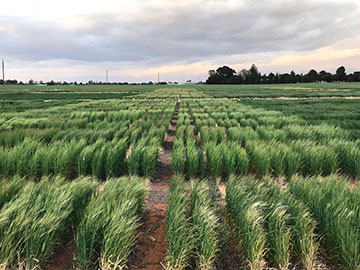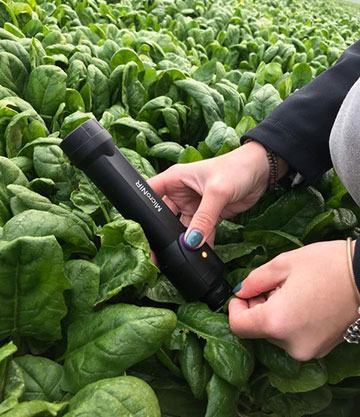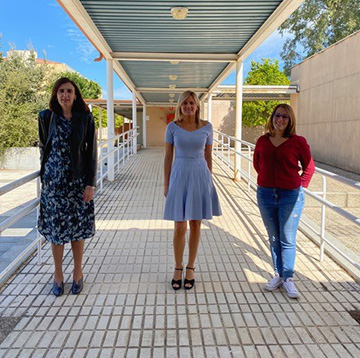
Frost-damaged barley in field trials. [Image: University of Adelaide]
In terms of both economic and food security, agricultural monitoring is a serious business. And there’s a growing need for reliable processes that guarantee the quality and safety of food along every step of the supply chain—from seed to shelf. Two research groups have recently leveraged rapid, non-destructive optical technologies to tackle different aspects of crop monitoring.
Enemy number one: Frost
Cereal crops like grain and barley are adaptable to many different environments—and to many different recipes. Thus these staple crops are grown in massive quantities around the world. Maximizing the yield of these agricultural standbys is crucial to the agri-economy, and although they’re adaptable, cereals are still affected by environmental stresses such as frost.
According to researchers at the University of Adelaide, Australia, a temperature change of just one degree can mean the difference between 10% frost damage and 90% frost damage in wheat plants. That’s why the researchers have enlisted terahertz imaging as a non-destructive means of screening grain for this condition (Opt. Express, doi: 10.1364/OE.404618).
“Frost damage costs growers hundreds of millions of dollars each year in Australia alone,” says the Adelaide team. “A rapid frost-damage detection method would assist growers in making the best economic decision for the plant after a frost event.”
Rapidity is key, the researchers explain, when deciding to continue until harvest or cut down damaged grains and turn them into hay, yet current methods of frost-damage detection are manual, laborious and time-consuming. Terahertz images, the team reasoned, “depict clear differences between severely frosted grain and unfrosted grain in a snapshot of the entire spike.” Such snapshots, the researchers say, reveal the exact position of individual grains as well as the development of the grain within the spike—all without destroying the plant.
Toward phenotyping and field use
To see how effective terahertz imaging would be at detecting frost damage in cereals, the Adelaide team analyzed sub-samples of barley spikes from different varieties in the lab. Using a vector network analyzer, they took transmission and reflection measurements at 275 GHz, a frequency at which there is low absorption from the grain. The resulting images clearly showed which barley spikes had suffered frost damage and which had survived the low temperatures, presenting as either “empty” or “full.”
In addition to its speed and accuracy, the researchers note the flexibility of their terahertz-imaging method, saying that the technique could ultimately help plant breeders to phenotype many different genotypes quickly and accurately after exposure to abiotic stresses to increase breeding efficiency.
In the future, the Adelaide team would like to create a prototype terahertz camera and test their method in the (literal) field. Compiling a database of crop thresholds for frost damage, it says, would help growers to make quick and confident decisions about their crops.
Near-infrared solutions

NIRS analysis of spinach plants directly in the field. [Image: Universidad de Córdoba]
A few continents away, a separate research group at the University of Córdoba, Spain, also looked to apply the speed and non-destructive nature of optical analysis to plant monitoring—but at a different frequency. Rather than terahertz imaging, the Córdoba team turned to near-infrared spectroscopy (NIRS) for in situ analysis of food quality and safety, both during the growing process and after harvest (Postharvest Biol., doi: 10.1016/j.postharvbio.2020.111273).
More intelligent quality control of food products could not only help growers to optimize harvest time, but also inform industry practices and ensure regulation compliance. The EU, for example, regulates nitrate content in various food products. Nitrates accumulate in leafy vegetables such as spinach from fertilizer and can impact human health; a higher nitrate content could disqualify a plant from being consumed fresh and instead relegate it to processing.
The Córdoba team, says co-author Dolores Pérez-Marín, thought to apply NIRS monitoring to the food supply chain as the sensors are non-destructive and provide instant feedback, compared with slow, expensive traditional methods of quality control. These qualities, says Pérez-Marín, allow the team to “control and monitor the whole production cycle,” which could “transform the role of quality assurance from one of just strictly conformance to one that addresses a wide range of business critical concerns.”
Another such concern that NIRS sensors could address, Pérez-Marín says, is food authentication and fraud prevention. Spectroscopy provides a digital fingerprint of a food product “that alerts the factory when that product fingerprint has been significantly changed.”
Digitizing food monitoring

María Teresa Sánchez, Lola Pérez and Irina Torres, investigators of the study. [Image: Universidad de Córdoba]
To show the power of NIRS in food monitoring, the team linked up with several companies interested in improving their vegetable monitoring systems through digitalization. Spinach plants—with their tricky nitrate concerns and short shelf life—proved to be the perfect test of the accuracy of NIRS.
The researchers adapted a NIR spectrophotometer in the spectral range of 908 nm to 1676 nm to provide in situ measurements of soluble solid content (SSC), which is helpful for optimizing harvest quality, and nitrate content. They implemented the handheld NIRS sensors at three major steps of the production cycle—analyzing 77 spinach plants in the field, during industry reception and after the leaves are cut and washed.
After collecting spectral data at each of the three control points, the team developed prediction models for quality and safety parameters. According to these results, the team writes, new-generation NIRS sensors are indeed capable of analyzing SSC and nitrate throughout the food supply chain.
In a digital age, explains Pérez-Marín, it’s important to have “a digital signal that can be processed to develop prediction models and that can be combined with other sensors.” NIRS is a powerful optical tool, she continues, that industry can harness for food monitoring, authentication and fraud prevention.
